Fabrication of MEMS Directional Acoustic Sensors for Underwater Operation
Abstract
1. Introduction
2. MEMS Underwater Sensor Design
Underwater Measurements
3. Dual-Wing Sensor Design
3.1. Underwater Measurements
3.2. Noise Measurement
4. Conclusions
Author Contributions
Funding
Acknowledgments
Conflicts of Interest
References
- Lasky, M. Review of World War I acoustic technology. U.S. NAVY J. Underw. Acoust. 1974, 24, 363–385. [Google Scholar]
- Ziomek, L.J. Sonar Systems Engineering; Taylor & Francis Group: Boca Raton, FL, USA, 2017. [Google Scholar]
- Pallayil, V.; Chitre, M.A.; Deshpande, P.A. Digital Thin Line Towed Array for Small Autonomous Underwater Platforms. In Proceedings of the Oceans 2007, Vancouver, BC, Canada, 29 September–4 October 2007. [Google Scholar]
- Maguer, A.; Dymond, R.; Mazzi, M.; Biagini, S.; Fioravanti, S.; Guerrini, P. SLITA: A new Slim Towed Array for AUV applications. In Proceedings of the Acoustics, Paris, France, 30 June–4 July 2008. [Google Scholar]
- Ehrlich, S.L.L.; Frelich, P.D. Sonar Transducer. U.S. Patent 3,290,646, 6 December 1966. [Google Scholar]
- Ehrlich, S.L.; Serotta, N.; Kleinschmidt, K. Multimode ceramic transducers. J. Acoust. Soc. Am. 1959, 31, 854. [Google Scholar] [CrossRef]
- Aronov, B.S. Calculation of first-order cylindrical piezoceramic receivers. Sov. Phys. Acoust. 1988, 34, 466–470. [Google Scholar]
- Beranek, L.L.; Mellow, T.J. Acoustics Sound Fields and Transducers; Elsevier: Oxford, UK, 2012. [Google Scholar]
- Edalatfar, F.; Azimi, S.; Qureshi, A.; Yaghootkar, A.; Keast, A.; Friedrich, W.; Leung, A.; Bahreyni, B. A Wideband, Low noise Accelerometer for Sonar Wave Detection. IEEE Sens. J. 2017, 18, 508–516. [Google Scholar] [CrossRef]
- Dymond, R.; Sapienza, A.; Troiano, L.; Guerrini, P.; Maguer, A. New vector sensor design and calibration measurements. In Proceedings of the Fourth International Conference of Underwater Acoustic Measurements: Technologies and Results, Kos Island, Greece, 20–24 June 2011. [Google Scholar]
- Akal, T.; de Bree, H.E.; Gur, B. Hydroflown based low frequency underwater acoustical receiver. In Proceedings of the 4th Interenet Conference & Exhibition In Underwater Acoustics Measurements: Technologies & results, Kos Island, Greece, 20–24 June 2011; pp. 871–878. [Google Scholar]
- Shipps, C.J.; Deng, K. A miniature vector sensor for line array applications. In Proceedings of the Oceans 2003, Celebrating the Past Teaming Toward the Future, San Diego, CA, USA, 22–26 September 2003. [Google Scholar]
- Shipps, C.J.; Abraham, B.M. The Use of Vector Sensors for Underwater Port and Waterway Security. In Proceedings of the Sensors for Industry Conference, New Orleans, LA, USA, 27–29 January 2004; pp. 41–44. [Google Scholar]
- Leslie, C.B.; Kendall, J.M.; Jones, J. Hydrophone for Measuring Particle Velocity. J. Acoust. Soc. Am. 1956, 28, 711–715. [Google Scholar] [CrossRef]
- Guan, L.; Zhang, G.; Xu, J.; Xue, C.; Zhang, W.; Xiong, J. Design of T-shape vector hydrophone based on MEMS. In Proceedings of the 16th International Solid-State Sensors, Actuators and Microsystems Conference, Beijing, China, 5–9 June 2011. [Google Scholar]
- Xue, C.; Tong, Z.; Zhang, B.; Zhang, W. A Novel Vector Hydrophone Based on the Piezoresistive Effect of Resonant Tunneling Diode. IEEE Sens. J. 2008, 8, 401–402. [Google Scholar] [CrossRef]
- Miles, R.N.; Rober, D.; Hoy, R.R. Mechanically coupled ears for directional hearing in the parasitoid fly Ormia Ochracea. Acoust. Soc. Am. 1995, 98, 3059–3069. [Google Scholar] [CrossRef] [PubMed]
- Touse, M.; Sinibaldi, J.; Simsek, K.; Catterlin, J.; Harrison, S.; Karunasiri, G. Fabrication of a microelectromechanical directional sound sensor with electronic readout using comb fingers. Appl. Phys. Lett. 2010, 96, 173701. [Google Scholar] [CrossRef]
- Downey, R.H.; Karunasiri, G. Reduced residual stress curvature and branched comb fingers increase sensitivity of MEMS acoustic sensor. J. Microelectromechanical Syst. 2014, 23, 417–423. [Google Scholar] [CrossRef]
- MEMSCAP® Inc. SOIMUMPs Design Handbook; MEMSCAP Inc.: Durham, NC, USA, 2011. [Google Scholar]
- Drake, R. Procedures for Calibration of Underwater Electroacoustic Transducers; ANSI/ASA Standard S1.20; Acoustical Society of America: Melville, NY, USA, 2012. [Google Scholar]
- Klose, T.; Conrad, H.; Sandner, T.; Schenk, H. Fluid-mechanical Damping Analysis of Resonant Micromirrors with Out-of-plane Comb Drive. In Proceedings of the COMSOL Conference, Hanover, Germany, 4–6 November 2008. [Google Scholar]
- Wilmott, D.; Alves, F.; Karunasiri, G. Bio-Inspired Miniature Directional Finding Acoustic Sensor. Sci. Rep. 2016, 6, 29957. [Google Scholar] [CrossRef]
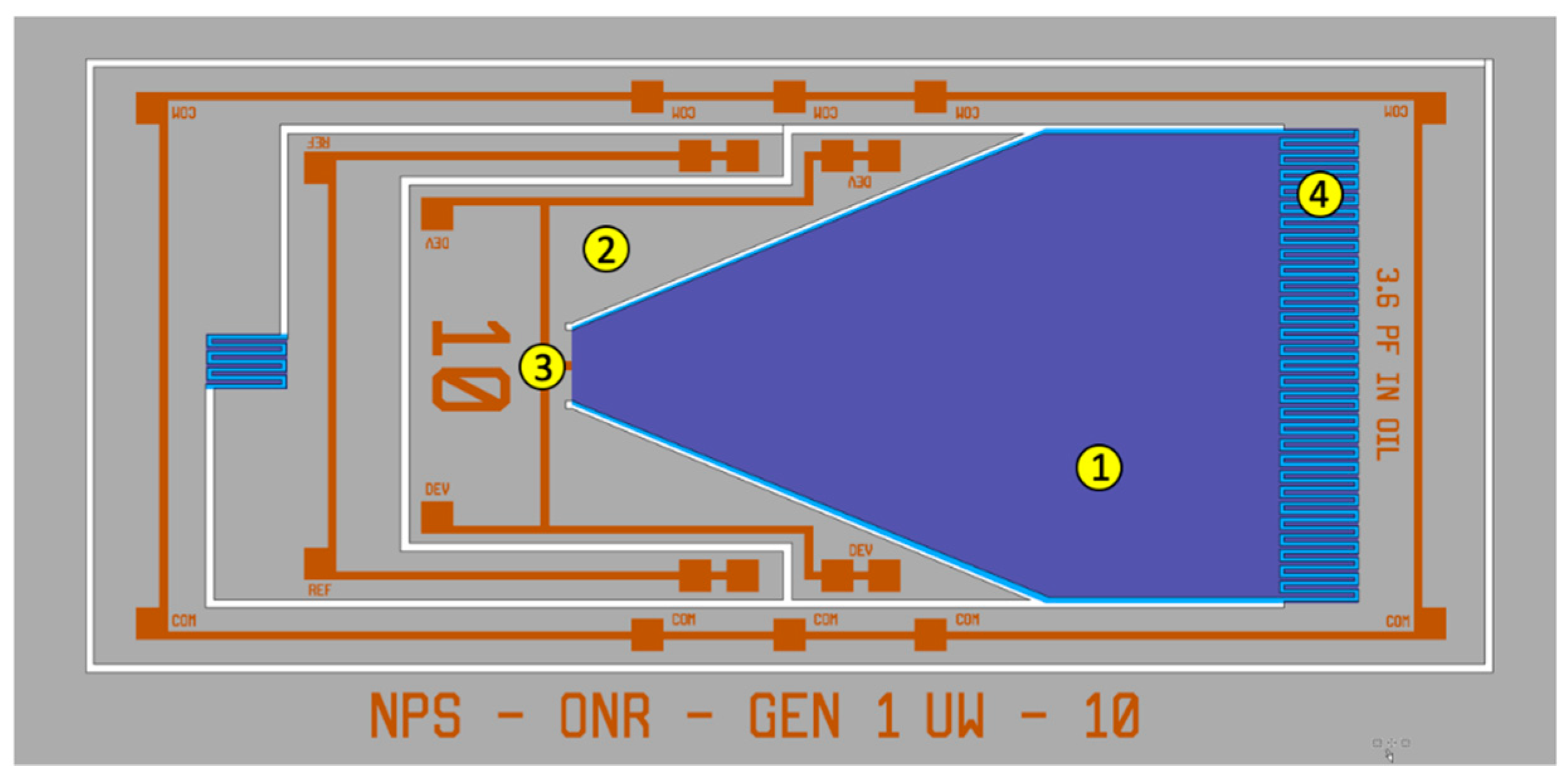

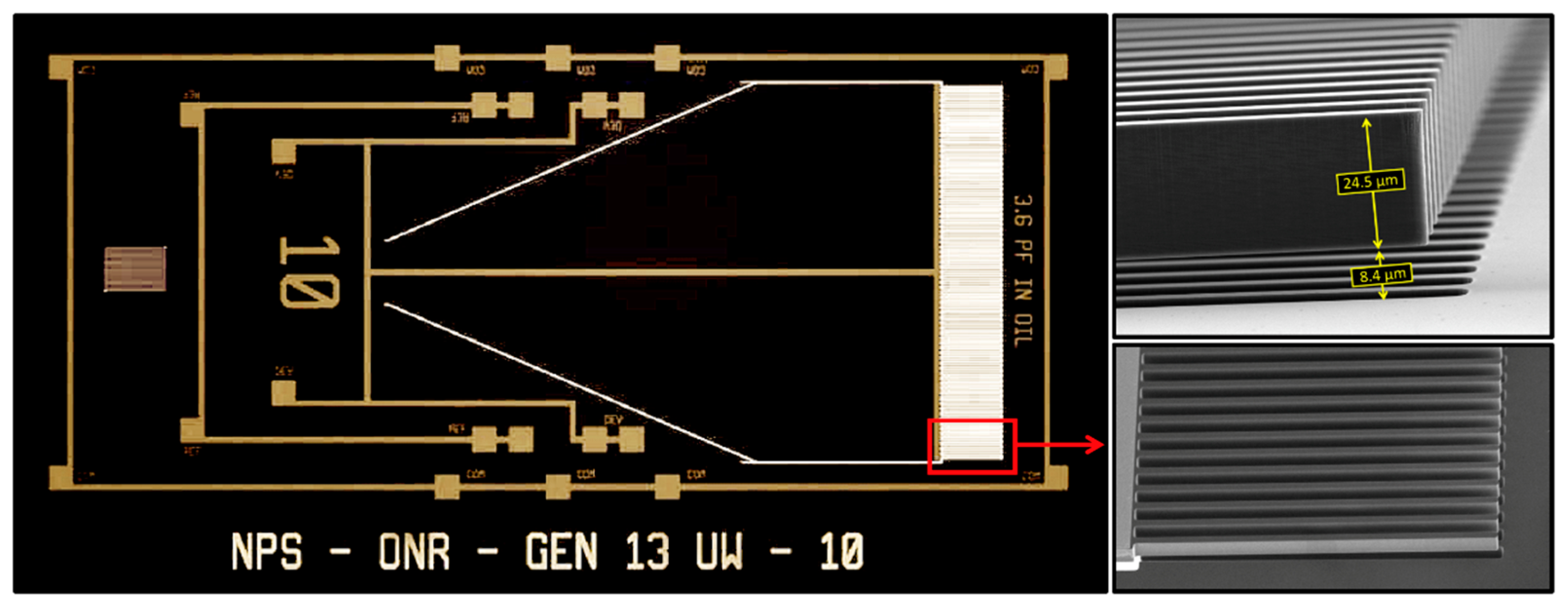
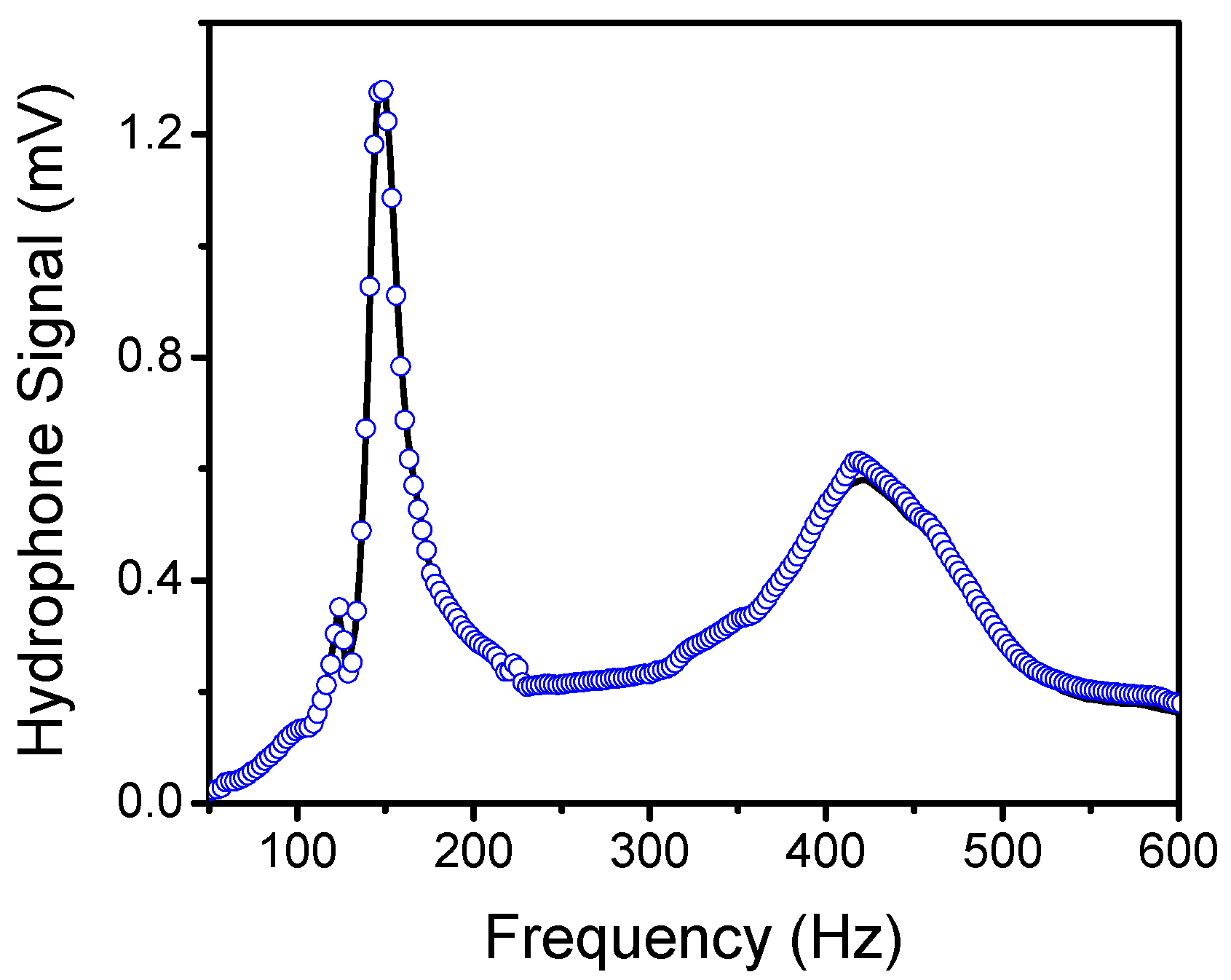
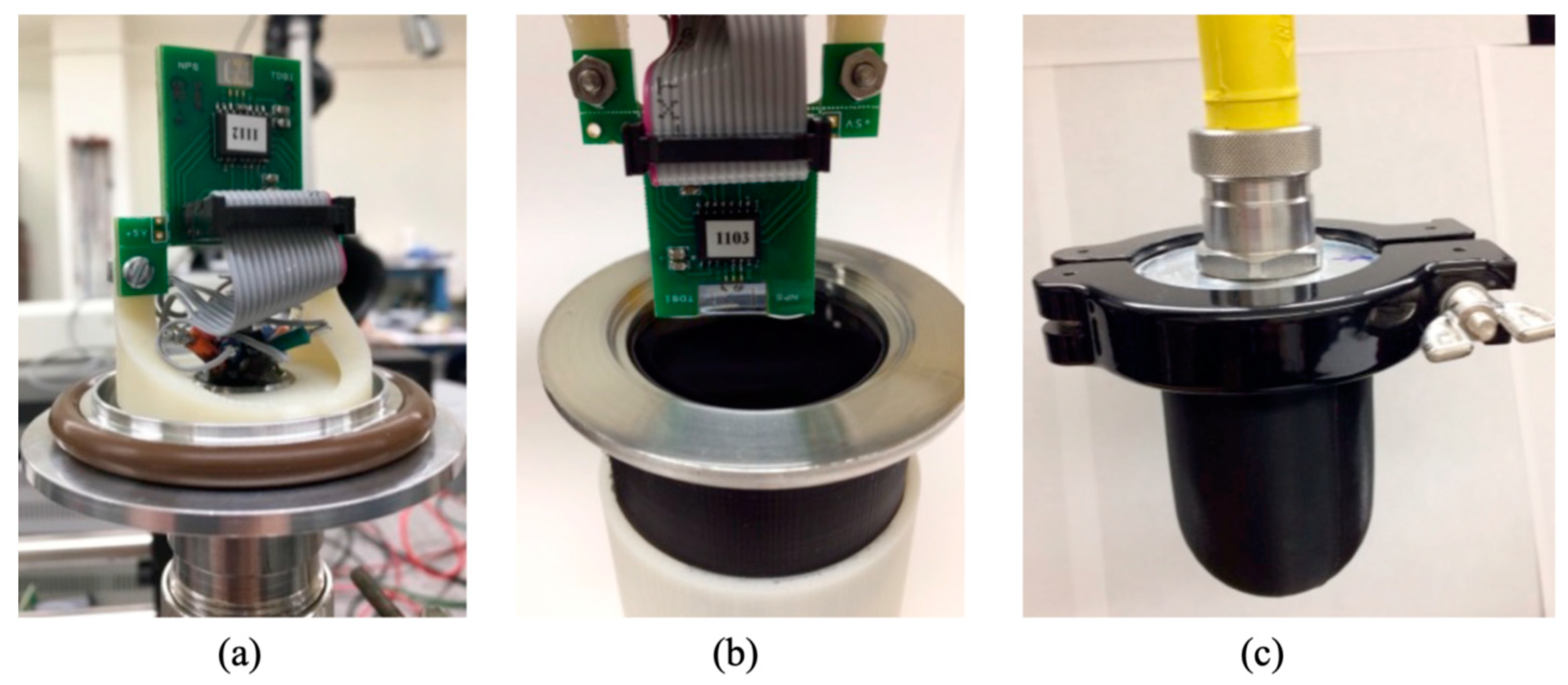
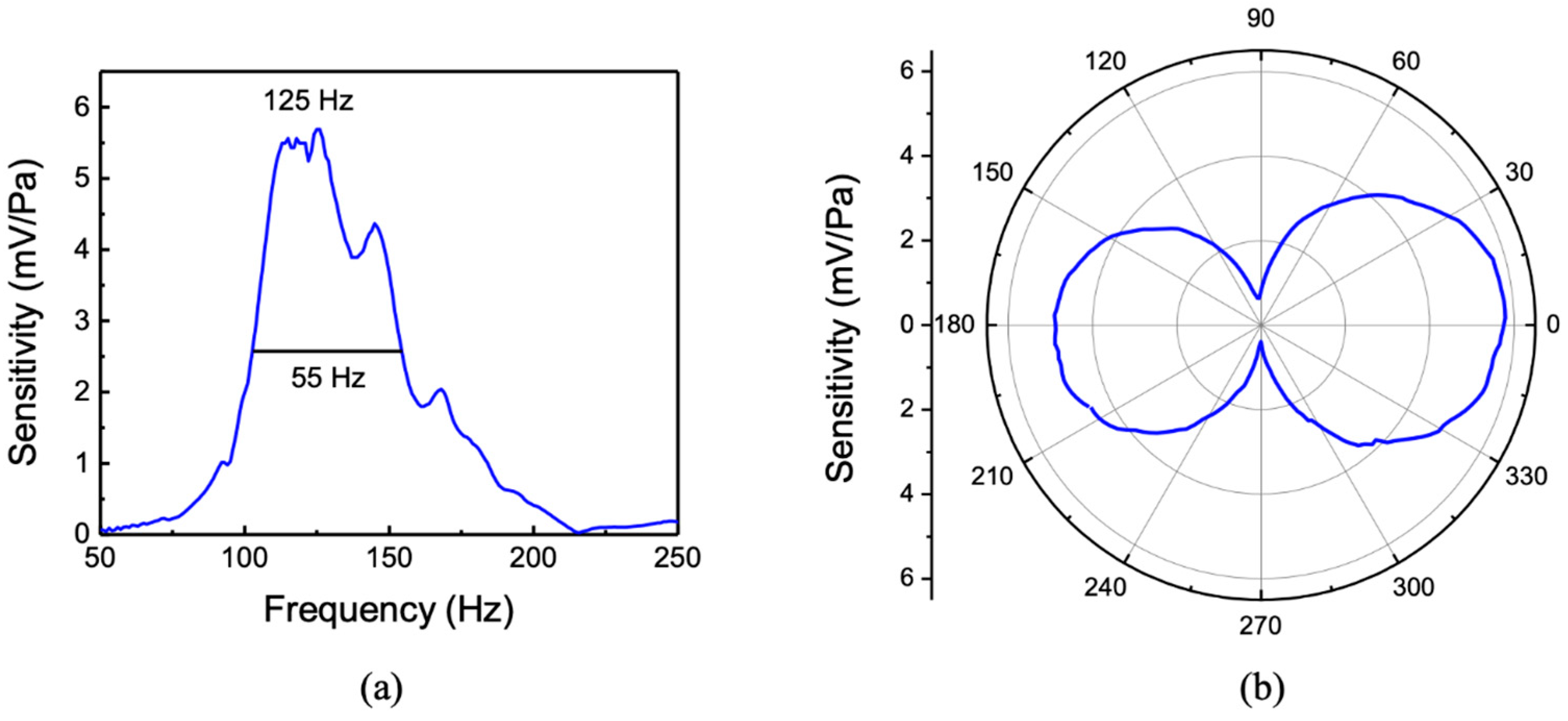
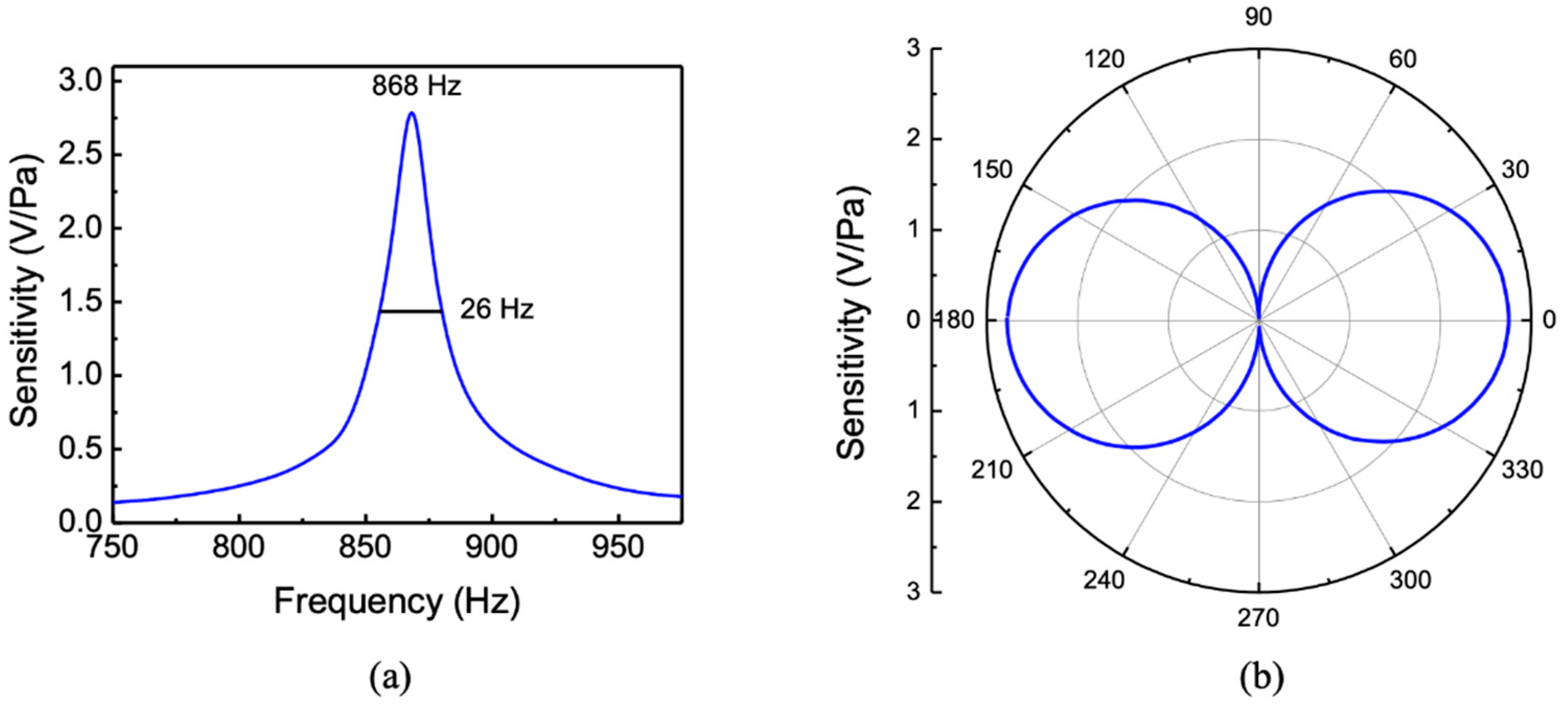

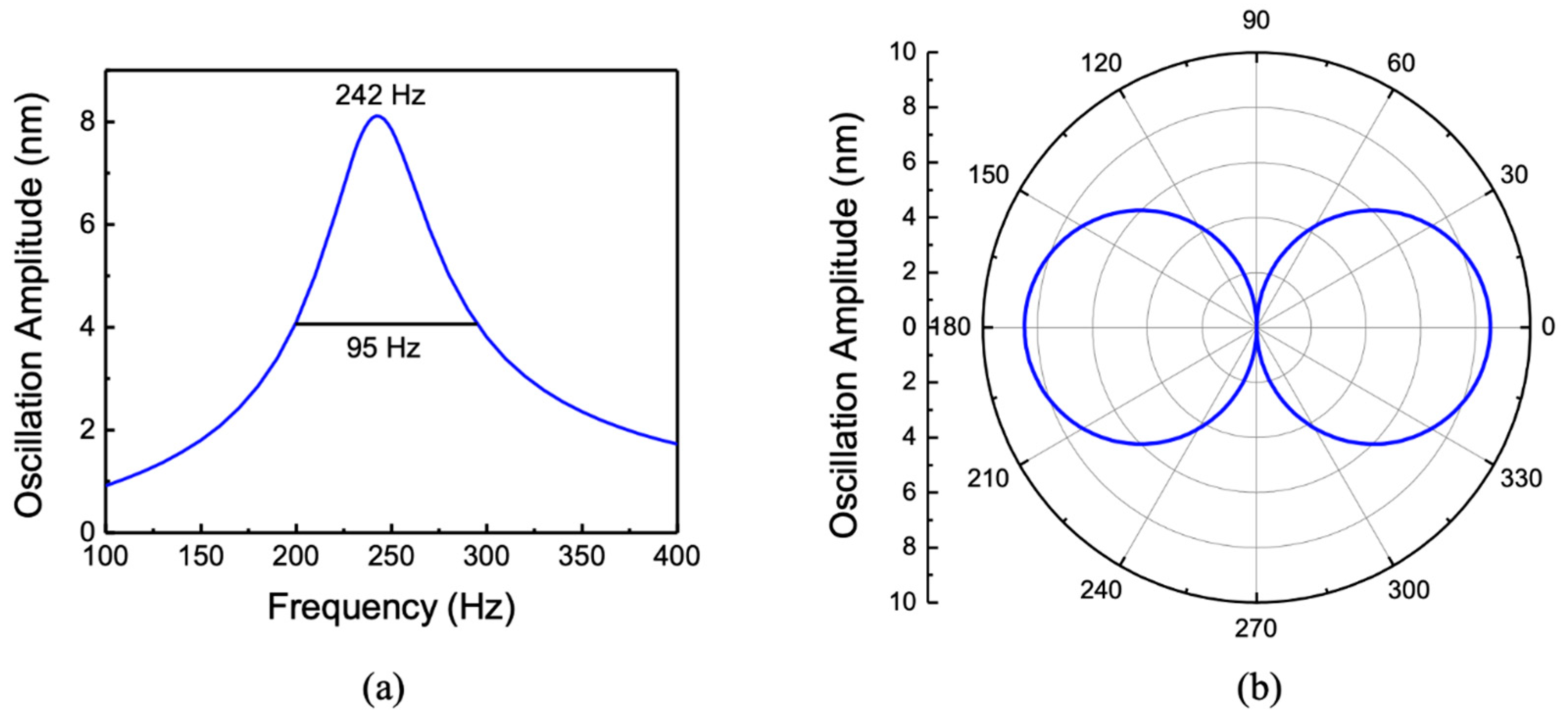
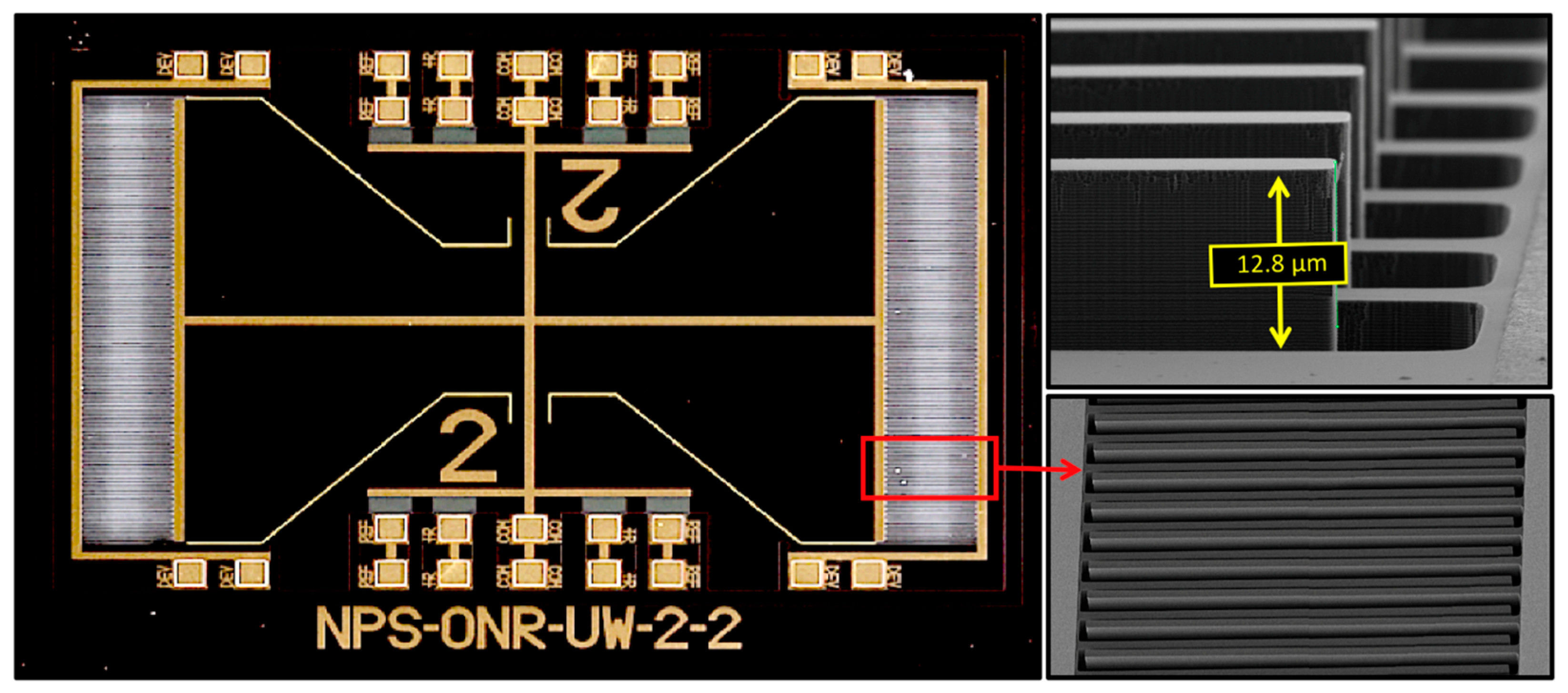
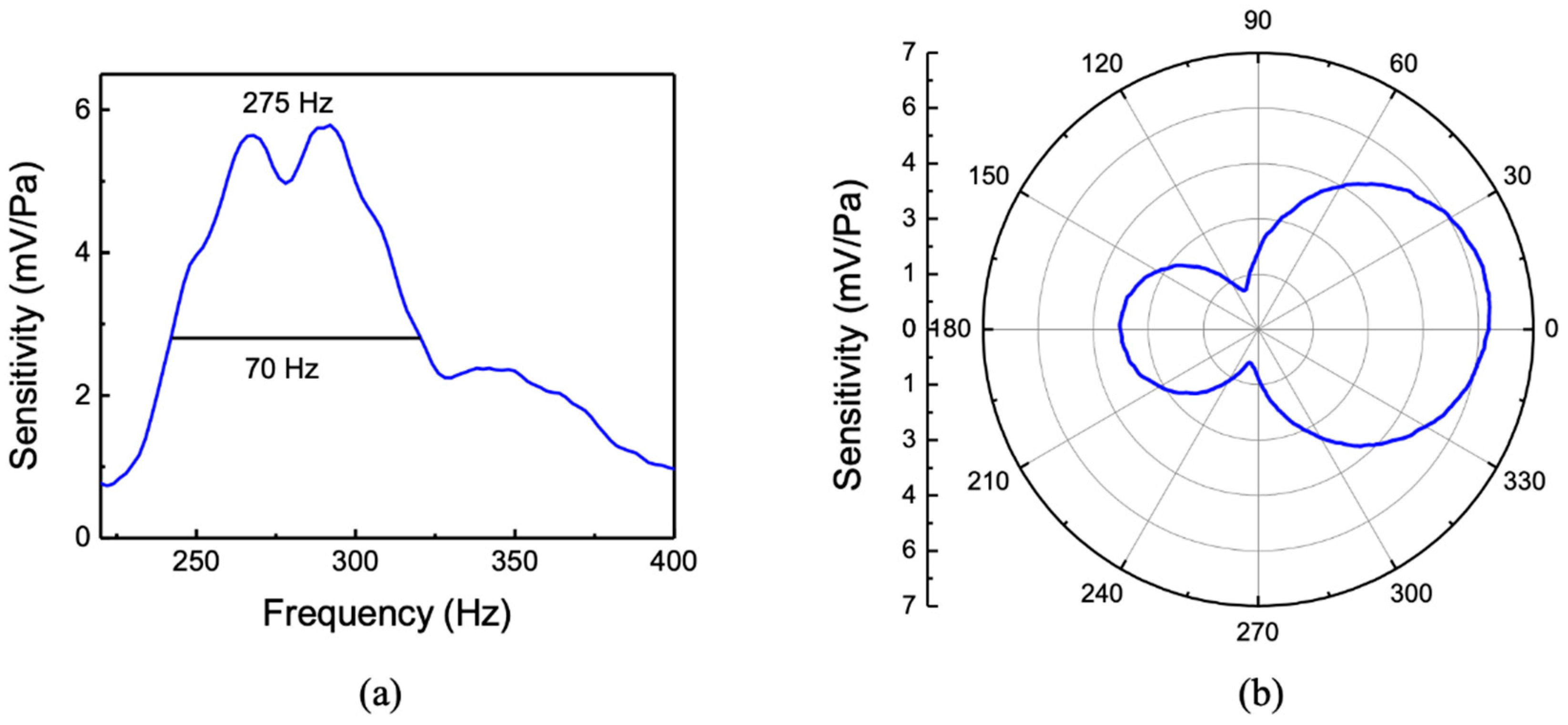
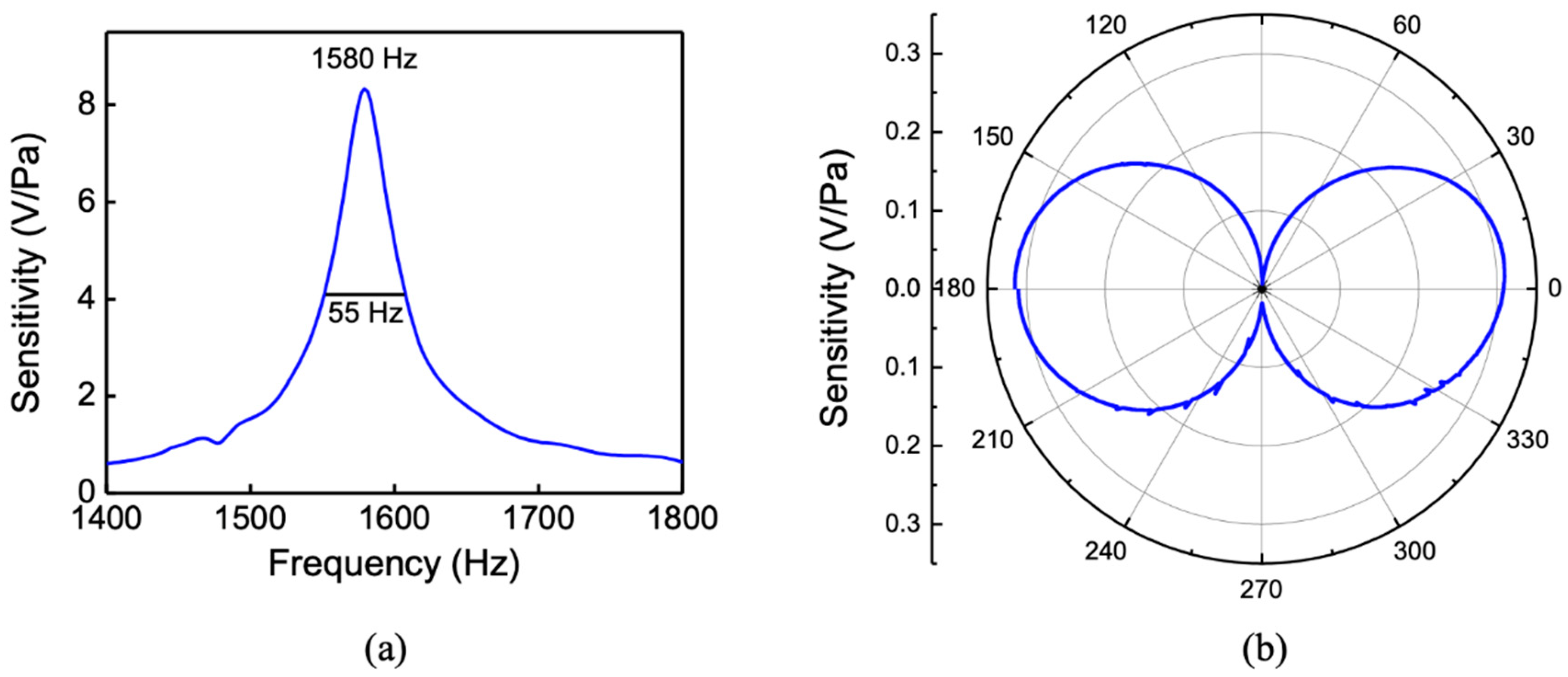
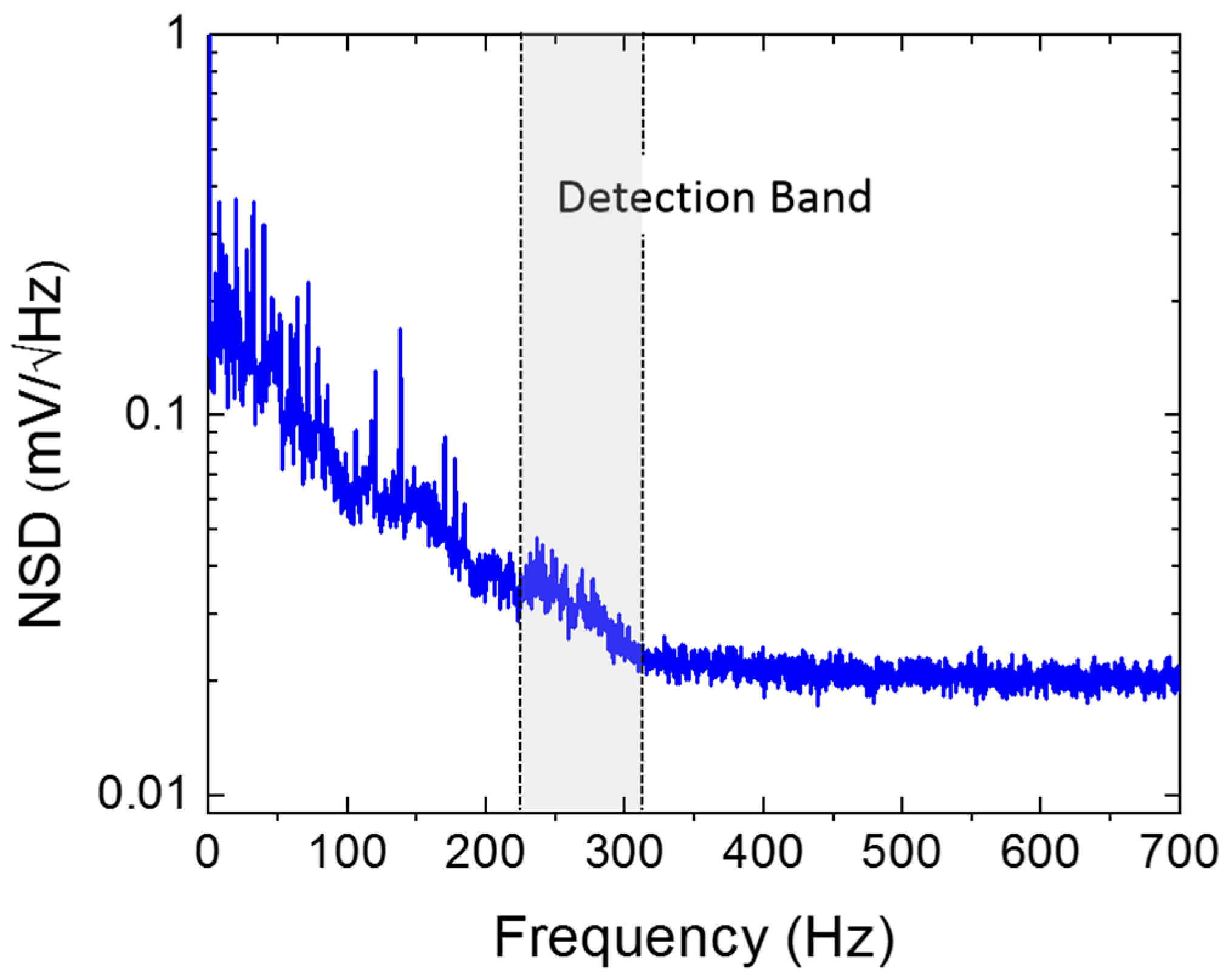
© 2020 by the authors. Licensee MDPI, Basel, Switzerland. This article is an open access article distributed under the terms and conditions of the Creative Commons Attribution (CC BY) license (http://creativecommons.org/licenses/by/4.0/).
Share and Cite
Espinoza, A.; Alves, F.; Rabelo, R.; Da Re, G.; Karunasiri, G. Fabrication of MEMS Directional Acoustic Sensors for Underwater Operation. Sensors 2020, 20, 1245. https://doi.org/10.3390/s20051245
Espinoza A, Alves F, Rabelo R, Da Re G, Karunasiri G. Fabrication of MEMS Directional Acoustic Sensors for Underwater Operation. Sensors. 2020; 20(5):1245. https://doi.org/10.3390/s20051245
Chicago/Turabian StyleEspinoza, Alberto, Fabio Alves, Renato Rabelo, German Da Re, and Gamani Karunasiri. 2020. "Fabrication of MEMS Directional Acoustic Sensors for Underwater Operation" Sensors 20, no. 5: 1245. https://doi.org/10.3390/s20051245
APA StyleEspinoza, A., Alves, F., Rabelo, R., Da Re, G., & Karunasiri, G. (2020). Fabrication of MEMS Directional Acoustic Sensors for Underwater Operation. Sensors, 20(5), 1245. https://doi.org/10.3390/s20051245



